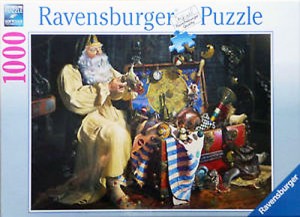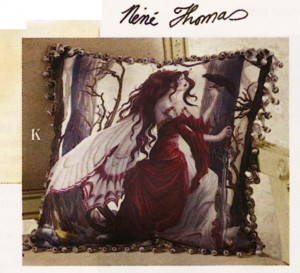
When we think of F/SF collecting art, we tend to think of paintings hanging on a wall, or (less often) sculptures sitting on a pedestal. The images are familiar to us because – most often – we’ve seen them before, gracing covers of magazines or game manuals or novels in the genre. Likewise, the names of the artists and their styles of painting are familiar to us, because we’ve seen their names credited on the books, or associated with role-playing or collector card games. But there are far more many ways for you to enjoy this kind of imagery, if you keep your eyes open, and open to buying consumer goods and/or mass-marketed “collectibles.”
One of the important ways commercial artists have made a living, since the 1960s (the start of the “collectibles” market “as we know it”) is through producing designs and products for merchandise, toys, and the biggest companies in the so-called “collectibles” industry – like Disney, Franklin Mint, The Bradford Exchange – and more recently, The Noble Co. and direct mail order merchandise companies that favor “fantasy” products.

Many artists whose names you ordinarily associate with fantasy art for book covers, like Stephen Hickman and Dean Morrissey, have simultaneously (and without some of us knowing it) put their imaginations and images to use in other markets.
It used to be – and as a first step – artists would dabble in tee-shirts. Rare was the artist, in fact, that wasn’t attracted to that simple article of clothing as a way to spread the word about their art. Other early outlets for their talent were greeting cards, lines of notecards, and calendars. Too many artists to list here advertised their talents – and

even made money – that way. Some of these products were self-published, and they continue to be popular choices for artists wanting to build their own brand through offerings of “merch” (merchandise). Dozens of artists are producing mugs, calendars, shirts, small wood boxes and even mouse pads with their own designs on them. And to varying degrees of success, they are marketing them on their own sites as well as those like Zazzle, Cafe Press and Etsy . . . and of course, eBay.
But it was those artists whose subject matter and styles of painting had wide-spread appeal,

that made them attractive to companies whose audience had grown to include fans of fantasy imagery. Household consumer goods as plebian as throw pillows and bedspreads carry artworks by fantasy artists such as David Delamare and Nene Thomas –

who are adept at/comfortable with, creating designs in tune with everyday consumer sensibilities. That is to say, “heavy” on fairy, angel or mermaid motifs. But household consumer goods are only one small piece of the market.
Along the way, artists as well known for their sensual, figurative fantasy paintings as Michael Whelan, Boris Vallejo and Julie Bell

have found new enthusiasts for their work through The Franklin Mint – limited edition product lines of “collectibles” — from tabletop dragon sculptures to folding pocket knives.

And I don’t even want to get into the long list of artists who have created designs for collector plate series.
That market is gone, but In their heyday, companies like the Bradford Exchange, Lennox, Franklin Mint and others
produced dozens of these – hired dozens of artists adept at depicting mythical castles and unicorns or known, licensed
characters for franchises like Star Wars and Star Trek and I Love Lucy (Darrell K. Sweet, Ken Barr, Morgan Weistling, Thomas Blackshear to name just a few)
Markets for consumer goods obey pop-cult and wider economic trends.

What might be appealing to audiences in the 1990s (gargoyles, for example, or garden gnomes) may well leave us cold in 2014. But if you keep your eyes and wallet open, you will find a steady stream of consumer products out there to satisfy your itch for fantasy and science fiction imagery.
The newest trend: DIY projects for the home. Get started now with a cross-stitch embroidery kit and you can have a lovely pillow for your sofa, come the winter Holidays 🙂










